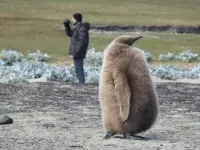Genomic sieve analysis can inform SARS-CoV-2 vaccine development
New paper describes how this research technique provides insights on potential mechanisms of vaccine protection and on risks for future vaccine resistance
2021-03-25
(Press-News.org) SILVER SPRING, Md. - As concern has grown over COVID-19 variants and their implications for how well COVID-19 vaccines will protect against the virus, researchers have proposed a method to examine instances of SARS-COV-2 infections in people who have received a COVID-19 vaccine.
Genomic sieve analysis of these so-called "breakthrough" SARS-CoV-2 infections in COVID vaccine trials is a critical tool to identify viral mutations associated with vaccine failure and to predict how vaccination impacts the virus' evolution.
Dr. Morgane Rolland, Chief of Viral Genetics for the U.S. Military HIV Research Program at the Walter Reed Army Institute of Research, and Dr. Peter Gilbert, biostatistician and professor at the Vaccine and Infectious Disease and Public Health Sciences Divisions at Fred Hutchinson Cancer Research Center, described the strategy in a recent publication in PLOS Pathogens.
"No vaccine is 100 percent effective, so even in clinical trials for the highly effective COVID vaccines being rolled out now, some of the trial volunteers who received the vaccine experienced breakthrough infections," explained Rolland. "Sieve analysis compares those breakthrough viruses to those that infected the placebo group to help pinpoint which variants are evading the vaccine-induced immune response and inform efforts to improve COVID vaccines."
Gilbert added, "Think of the vaccine as a sieve and different variants as pebbles poured into the sieve: the vaccine will block some variants but allow others to pass through, and sieve analysis learns which variants make it through."
Sieve analysis allows scientists to recognize evolutionary patterns that will be key to infer how SARS-CoV-2 might adapt to widely used vaccines and predict how virus evolution could eventually impact vaccine efficacy. The paper's authors note SARS-CoV-2 is relatively slow to mutate, meaning it's unlikely current vaccines will be rendered obsolete soon, but increased vigilance is needed in the months until a majority of the population has been vaccinated to stem spread of concerning variants.
"The variants that emerged in the past two months highlight the need for next generation vaccines," said Rolland. "Conducting sieve analysis of samples obtained through vaccine trials is an efficient way to determine how future vaccines should be designed."
INFORMATION:
About MHRP
The U.S. Military HIV Research Program (MHRP), part of the Walter Reed Army Institute of Research, is at the forefront of the battle against HIV/AIDS to protect U.S. troops from infection and reduce the global impact of the disease. MHRP has been recognized as a leader in HIV diagnostics, epidemiology and vaccine research for over three decades and, more recently, has built an international reputation for pioneering discoveries in acute infection and remission. Its research is supported by a cooperative agreement (W81XWH-18-2-0040) between the Henry M. Jackson Foundation for the Advancement of Military Medicine, Inc. (HJF), and the U.S. Department of Defense (DOD). The views expressed are those of the authors and should not be construed to represent the positions of the U.S. Army, the Department of Defense, or HJF.
[Attachments] See images for this press release:

ELSE PRESS RELEASES FROM THIS DATE:
2021-03-25
Scientists at Sinai Health say they have discovered a new pathway that controls dangerous overreactions in a body's immune system, including deadly forms of hyper-inflammation.
In new findings out today in the journal Science, researchers at the Lunenfeld-Tanenbaum Research Institute (LTRI) detail how a protein known as WAVE2, a protein expressed in all immune cells, plays a critical role in maintaining immune system balance.
As part of the research, scientists knocked out, or turned off, WAVE2 in a subset of immune cells in mice, which led to severe autoimmunity and inflammation, ...
2021-03-25
Despite having remarkable utility in treating movement disorders such as Parkinson's disease, deep brain stimulation (DBS) has confounded researchers, with a general lack of understanding of why it works at some frequencies and does not at others. Now a University of Houston biomedical engineer is presenting evidence in Nature Communications Biology that electrical stimulation of the brain at higher frequencies (>100Hz) induces resonating waveforms which can successfully recalibrate dysfunctional circuits causing movement symptoms.
"We investigated the modulations in local ?eld potentials induced by electrical stimulation of the subthalamic nucleus (STN) at therapeutic ...
2021-03-25
Tel-Aviv, ISRAEL - March 25, 2021 - Wild Biotech, a preclinical stage drug discovery & development company emerging out of stealth mode, today announces the publication of its first major paper, which appears in the journal Science. The study mapped the gut microbiota of animals in the wild on an unprecedented scale, adding millions of potentially novel microbiome-based therapeutics for human diseases to the company's already massive database. Wild will use these findings to first tap its database for targets in inflammatory, immune and gastrointestinal diseases.
"For the study, we collected gut microbiota from almost 200 species of animals in the wild, covering diverse classes, feeding behaviors, geographies, and ...
2021-03-25
Water scarcity in rural Alaska is not a new problem, but the situation is getting worse with climate change. Lasting solutions must encourage the use of alternative water supplies like rainwater catchment and grey water recycling. They must also address the affordability of water related to household income, say researchers from McGill University.
Washing hands with clean water is something most people take for granted, yet for Alaska's rural residents, this is often not the case. When people pay for water by the gallon, serious thought is given to how much is used - even during the COVID-19 pandemic.
In many rural Alaskan communities, where jobs are scarce and household income is low, the cost of water is a high burden, according to the study published in Environmental ...
2021-03-25
A medical device that has been shown to manage pain among babies born preterm can also help keep their brain oxygen levels steady during medical procedures, finds new analysis by researchers at UBC.
The device, called Calmer, is a pillow-sized therapeutic bed covered in soft fabric and inserted into the incubator. It can be programmed to mimic a parent's heartbeat and breathing rate-- providing a soothing presence by moving up and down gently to simulate a breathing motion and heartbeat sound for the baby when their parent cannot be present.
"For newborns and particularly for preterm babies, it's critical to keep overall blood oxygen levels steady, especially in the brain. The more stable their brain oxygenation is, the better for their brain development," ...
2021-03-25
Researchers at the Georgia Institute of Technology have uncovered an innovative way to tap into the over-capacity of 5G networks, turning them into "a wireless power grid" for powering Internet of Things (IoT) devices that today need batteries to operate.
The Georgia Tech inventors have developed a flexible Rotman lens-based rectifying antenna (rectenna) system capable, for the first time, of millimeter-wave harvesting in the 28-GHz band. (The Rotman lens is key for beamforming networks and is frequently used in radar surveillance systems to see targets in multiple directions without physically moving the antenna system.)
But to harvest enough power to supply low-power devices at long ranges, large aperture antennas are required. The problem with ...
2021-03-25
Researchers at Baylor College of Medicine, Shandong University in China and other institutions may have found an explanation for dawn phenomenon, an abnormal increase of blood sugar only in the morning, observed in many patients with type 2 diabetes. They report in the journal Nature that mice lacking the circadian clock gene called Rev-erb in the brain show characteristics similar to those of dawn phenomenon.
The researchers then looked at Rev-erb gene expression in patients with type 2 diabetes comparing a group with dawn phenomenon to a group without it and found that the gene's expression followed a different temporal pattern between these two groups. The findings support the idea that an altered daily rhythm of expression of the Rev-erb gene may underlie dawn phenomenon. Future ...
2021-03-25
WASHINGTON (March 25, 2021)--Although demand for COVID-19 vaccines currently seems high, vaccine hesitancy could pose a major threat to public health efforts to end the pandemic, according to an editorial published today in the journal Science.
The authors, including David A. Broniatowski, associate director of the George Washington University Institute for Data, Democracy & Politics, point out that public sentiment towards vaccines are volatile in the face of events such as the recent controversy surrounding the AstraZeneca vaccine clinical trial data. For example, some people could develop safety concerns due to the news reporting about the AstraZeneca vaccine and then turn down the chance to ...
2021-03-25
Narcissism is driven by insecurity, and not an inflated sense of self, finds a new study by a team of psychology researchers. Its research, which offers a more detailed understanding of this long-examined phenomenon, may also explain what motivates the self-focused nature of social media activity.
"For a long time, it was unclear why narcissists engage in unpleasant behaviors, such as self-congratulation, as it actually makes others think less of them," explains Pascal Wallisch, a clinical associate professor in New York University's Department of Psychology and the senior author of the paper, which appears in the journal Personality and Individual Differences. "This has become quite prevalent in the age of social media--a behavior that's been coined 'flexing'.
"Our ...
2021-03-25
A study by prof. Bas van Bavel and prof. Marten Scheffer shows that throughout history, most disasters and pandemics have boosted inequality instead of levelling it. Whether such disastrous events function as levellers or not, depends on the distribution of economic wealth and political leverage within a society at the moment of crisis. Their findings on the historical effects of crises on equality in societies are now published open access in Nature HSS Communications.
It is often thought that the main levellers of inequality in societies were natural disasters such as epidemics or earthquakes, and social turmoil such as wars and ...
LAST 30 PRESS RELEASES:
[Press-News.org] Genomic sieve analysis can inform SARS-CoV-2 vaccine development
New paper describes how this research technique provides insights on potential mechanisms of vaccine protection and on risks for future vaccine resistance




